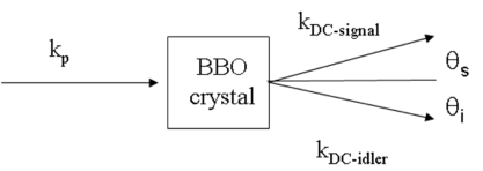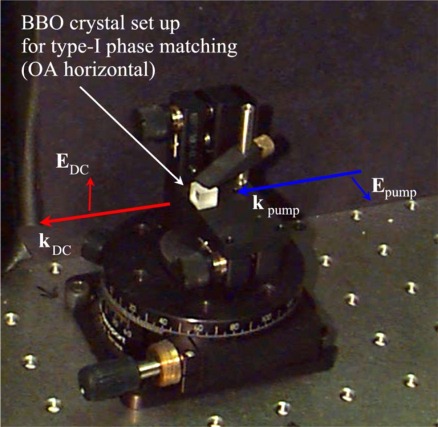
Down Conversion
Spontaneous parametric down conversion or parametric fluorescence is the nonlinear process whereby two photons (called idler and signal) are created from a parent photon (called the pump photon).

The down converted (DC) photons are produced simultaneously and are correlated in energy and momentum:
Ep = EDC-signal + EDC-idler
kp = kDC-signal cos qs
+ kDC-idler cos qi
where E = hc/l and k = 2p/l are respectively the energy and the wave number of the photons of wavelength l. For the degenerate case (lDC=lDC-signal = lDC-idler) these laws impose the following condition on the indices of refraction of pump and DC light:
n (lpump) = n (lDC)
cos q, (1)
where q is the angle that the DC beams form
with the direction of the pump inside the crystal.
For Type-I phase matching, DC light is polarized perpendicular to the optic axis
(OA) of the crystal and n (lDC) =
no (ordinary index of refraction). The polarization of the pump
beam is in the same plane as OA: n (lp)
= ne(fpm), where
ne(fpm) =( cos2fpm
/ no2 + sin2fpm
/ ne2 )-1/2
with fpm being the "phase matching angle." We use BBO crystals, which have indices of refraction given by:
n (l) = ( A+B / (l2 + C) + D l2 )1/2
where the constants for no and ne are:2
| n | A | B (mm2) | C (mm2) | D (mm-2) |
| no | 2.7359 | 0.01878 | -0.01822 | -0.01354 |
| ne | 2.3753 | 0.01224 | -0.01667 | -0.01516 |
We can use these relations to find the phase matching angle that we need. The figure below shows one of our setups.

The crystal is mounted on a prism mount, which is attached to a rotation mount. The latter is used for adjusting the phase matching angle. The input pump (blue) laser beam was polarized in the horizontal plane. The down converted light thus emerges polarized in the vertical plane. The crystal shown above was not cut to the exact phase-matching angle, so it had to be rotated by about 5 degrees.
NOTE: If you do not know in which plane the optic axis is contained, there is an easy way to find out. If you lay the crystal on top of a grid paper, as seen from the point of view of the pump beam. The optic axis will be contained in a plane that is perpendicular to the plane of the paper (if the crystal was cut correctly). From your point of view this plane would be a line. The image of the grid paper will appear double in the direction of this line. This double image is similar to the one produced by a calcite crystal.
For vendors we recommend Newlight Photonics Inc. They sell crystals for competitive prices.
2K. Kato, IEEE J. Quantum Electron. QE-22, 1013 (1986).
E. Galvez/Colgate U.